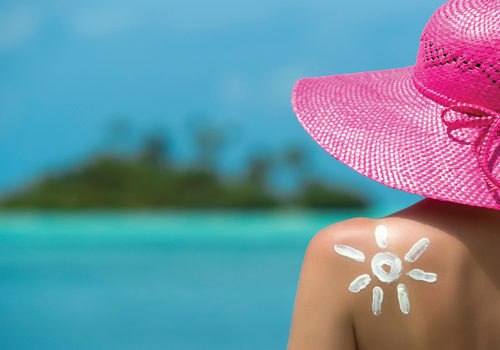Over two million Americans are diagnosed annually with skin cancer, according to the Skin Cancer Foundation. People believe that slathering on sunscreen will protect their skin from harmful rays, but in reality, two-thirds of conventional sunscreens are not strong enough to shield against all of them.Some sunscreens even contain toxic chemicals that could harm the user.
What’s Wrong with Conventional Suncreens?
The main concern with chemical sunscreens is that the ingredients that form their skin protection factors (SPF) are aimed at UVB rays, the primary cause of sunburn. These products are poorly equipped to block the UVA rays that penetrate the skin deeper; therefore, they may not prevent skin damage other than sunburn (1).
Of the six main active ingredients in conventional sunscreens—avobenzone, homosalate, octinoxate, octisalate, octocrylene and oxybenzone—five penetrate the skin, three disrupt hormones, four show moderate to high rates of promoting allergic reactions and one produces toxic products when it breaks down (1). Some believe these ingredients are safe, but others prefer different options for sun protection.
Mineral Sunscreens: Zinc Oxide and Titanium Dioxide
Mineral sunscreens may be a safer and more effective alternative to brand-name chemical sunscreens. These sunscreens, made with minerals like zinc oxide and titanium dioxide, provide sun protection with few health concerns (1).
Zinc oxide is known to be safe from its years in calamine lotion and diaper creams. It protects the deeper layers of the skin by reflecting and absorbing UVA and UVB rays on the skin’s surface (2). Not only does zinc oxide better protect against both types of rays than regular sunscreens, but the harmful effects are negligible. In studies, there was no evidence of hormone disturbance or allergy induction, and less than 0.01% of the zinc oxide was found to penetrate the skin (1).
Although not as effective as zinc oxide at protecting against UVA rays, titanium dioxide has still shown to be more effective than the chemicals in non-mineral sunscreens (1). In trials, titanium dioxide showed no evidence of skin penetration, hormone disruption or allergies (2).
Many natural sunscreens also contain botanicals for moisturizing and soothing the skin like coconut oil, aloe vera, green tea and more (3).
Nanoparticles and Photo Activity
Despite their efficacy, sunscreens containing these minerals are not without their concerns. The most prominent of these issues is nanoparticles. Although not yet defined by the U.S. Food and Drug Administration, a nanoparticle is generally regarded as a particle measuring less than 100 nanometers (2). Products with titanium dioxide have recently been in this form to minimize the white, chalky appearance of the mineral (1). The concern with these particles is that their smaller size could possibly increase their potential to travel through the lungs and the bloodstream (2). But can this really happen, and could nanoparticles be dangerous?
To research the potentially harmful effects of nanoparticles, researchers tested zinc oxide particles of 19 and 110 nanometers on human volunteers. Less than 0.01% of the mineral entered the bloodstream from either particle size (1). A 2014 Australian study found that human immune cells absorbed and broke down zinc oxide nanoparticles when directly exposed to them (4). In addition, previous research suggests nanoparticles are only a concern in powder or spray form due to possible inhalation (2). While these studies suggest that nanoparticles may not be a problem, many shoppers do not want them in products due to health and environmental concerns. Therefore, many minerals sunscreens are free of nanoparticles (2, 3).
The second concern of mineral based sunscreens is photo activity. Could these minerals produce free radicals that may damage cells (2)? The levels of photo activity in mineral ingredients are lower than in chemicals, and surface coatings on the nanoparticles can reduce this photoactivity by up to 99%. These safety concerns are still being researched, but many skin care experts still believe that these minerals are the best sun-protecting ingredients on the market (2).
Ultimately, the best protection against the sun is protective clothing, sunglasses, shade and avoiding the outdoors in the harshest sun hours (1), but if you can not stay out of the rays, be sure to tell shoppers about mineral sunscreens. WF
References
1. Environmental Working Group’s 2014 Guide to Sunscreens, 2015, ewg.org.
2. W.S. Badger Company, Inc., www.badgerbalm.com, accessed April 22, 2015.
3. Goddess Garden, www.goddessgarden.com, accessed April 22, 2015.
4. Cancer Council Australia, cancer.org.au, accessed April 22, 2015.
Published in WholeFoods Magazine, June 2015









